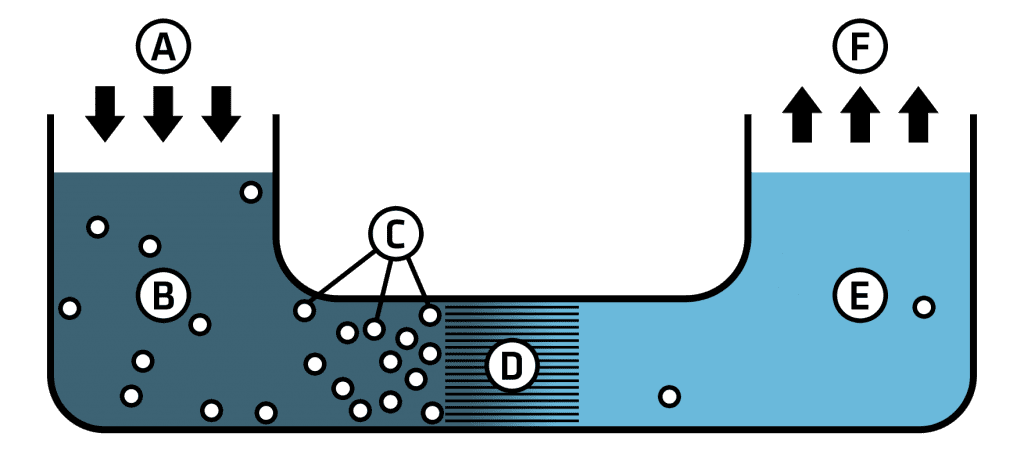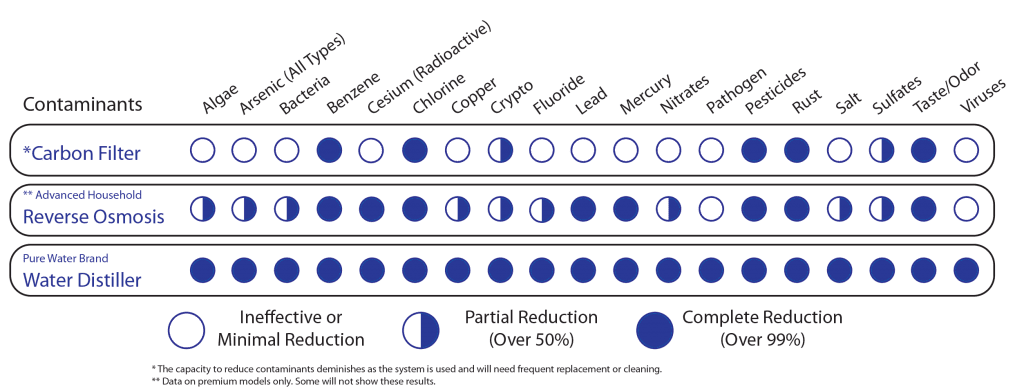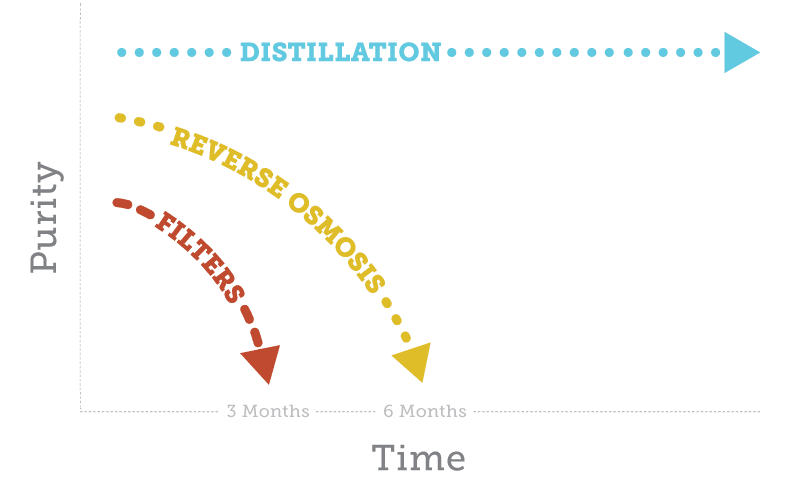When you’re deciding what kind of water purification system you and your family need, there’s a lot to consider: effectiveness, cost, maintenance, environmental impact… the list goes on. But if you’ve narrowed down your decision to water distillation vs reverse osmosis, you’re in the right place.
This article goes into depth about the differences between water distillation and reverse osmosis. If you’re looking for a quick overview of water purification tools, please watch this short video, which also covers filters.
We want to make this decision easy for you and your family while ensuring you get the best possible water at the best price. So let’s break it down.
How Water Distillation and Reverse Osmosis Systems Work
Reverse Osmosis
Reverse osmosis is a process that employs a barrier in its operation. On one side of the barrier is raw water and on the other is the filtered water.

A – Applied pressure
B – Seawater/Sourcewater in
C – Contaminants
D – Semi-permeable membrane
E – Potable water out
F – Distribution
The reverse osmosis process forces water under pressure through a synthetic semi-permeable membrane. In theory, the membrane prevents contaminants from passing, while allowing treated water to pass through. Large contaminants, like heavy salts, get trapped in the source water.
There are different types of RO membranes, but they all function based on these general principles. Local water conditions dictate which membrane is recommended.
Unfortunately, all barriers eventually break down, clog and deteriorate -which is why you have to change your filters periodically. This means that you never know how effective the membrane (filter) is, or what contaminants might be passing through this barrier.
Water Distillation
The process of water distillation does not involve a “barrier,” but uses a full phase change to separate pure water from the contaminants. Basically, this process mirrors nature’s own water purification cycle.

The distillation process starts with boiling water to create steam (mirroring evaporation). This also kills biological contaminants! The steam separates from the contaminants, leaving them behind as the steam enters the condensing coil. And finally, the steam condenses into pure water.
What about impurities that evaporate before the water does? Home water distillers are usually paired with a simple barrier filter, like a carbon filter, to ensure maximum purity. (Every Pure Water distiller has a patented dual vent system and comes with a carbon filter. Combined, these remove chemicals with a boiling point lower than that of water.)
Key Takeaway: Reverse Osmosis uses a barrier (membrane) which can break down over time. Water Distillation uses a phase change for consistent purity.
Which Contaminants Are Removed By Water Distillation vs Reverse Osmosis?

There are 4 main types of contaminants in water: Biological, Organic, Inorganic, and Radioactive. Reverse osmosis and water distillation handle each category differently.
Biological Contaminants
Let’s start with biological contaminants. This category includes things like bacteria and viruses, giardia cysts, and parasites – nasty contaminants that can make you very sick very quickly.
Reverse osmosis systems do not kill bacteria or other biological contaminants, and some systems can actually cause bacteria to grow and multiply in the membrane. In fact, if your tap water is contaminated with bacteria, you should NOT use a reverse osmosis system.
If there is ever a situation where your community issues a boil water alert (boil alerts are specifically meant to address biological contamination), there are important steps you will need to take to disinfect your reverse osmosis membranes, and you may still need to replace them.

Biofilm buildup is the biggest problem in RO systems, and it causes about 35% of membranes to fail. Cleaning won’t fix it. “No treatment or combination of treatments was completely effective or effective at all stages of biofilm development.”
Distillation, on the other hand, boils water as part of the purification process. This kills biological contaminants and then it removes and separates the pure steam, leaving the dead bacteria behind. You don’t have to worry about biofilm breaking your distiller.
Organic Contaminants
Organic, in this case, means carbon-based contaminants. This category contains pollutants like insecticides, pesticides, and herbicides (including glyphosate, which is better known as RoundUp).
In this category, you might assume that reverse osmosis is going to be the winner. After all, lots of organic contaminants are what we call Volatile Organic Compounds (VOCs), and they have a lower boiling point than water. A few older studies have reported that volatile organic compounds can distill over with water vapor.
However, most, if not all, distillers today are designed to be combined with a carbon filter as standard, which absorbs any VOCs in the water. Pure Water distillers go a step further and have a patented dual vent system too, which vents off many of these contaminants. They also come with a carbon filter. Combined, these remove chemicals with a boiling point lower than that of water at a rate of over 99%.
The effectiveness of reverse osmosis, on the other hand, varies based on the age and upkeep of the membrane. Most organic substances with a molecular weight over 100 are sieved out, but not all.
When it comes to water distillation vs reverse osmosis for removing organic contaminants, distillation still wins.
Inorganic Contaminants
When water distillation and reverse osmosis go head-to-head on to remove inorganic contaminants, we’re looking at impurities like chlorine, asbestos, mercury, arsenic, and lead. Most people think about these contaminants when they worry about their water quality.
Distillation removes or reduces inorganic (mineral) contaminants very effectively. In most cases, removal rates in our third-party lab results are 99+%. If there are issues operating the distiller because there are too many salts or heavy inorganic contaminants, you can solve this by using softened water for the feedwater.
Reverse osmosis systems were designed for removing inorganics. Salt ions are easily rejected by the system, so they do a decent job of removing these. Again though, how effective it is depends on the age and maintenance of the membrane.
Radioactive Contaminants
Radioactive contaminants include impurities like plutonium, uranium, and strontium 90. Many people don’t realize that this contamination doesn’t just come from countries dumping radioactive waste; some radioactive contaminants, like uranium, often contaminate water naturally.
But good news: many radioactive contaminants are just isotopes of inorganic compounds.
As water distillers and reverse osmosis membranes both remove most inorganics, it follows that they would also be effective in removing inorganic radiologic contaminants.
The test data for removing radioactive contaminants is limited. However, we have conducted third-party lab testing to confirm that Pure Water distillers remove uranium from water.
Key Takeaway: Reverse Osmosis removes many contaminants, but Water Distillation removes more.
The Pros and Cons of Each System
What else should you consider when comparing reverse osmosis vs water distillation?
Performance Over Time
As we mentioned earlier, reverse osmosis uses a physical barrier for water purification while water distillation uses a phase change. Unfortunately, physical barriers can break down and lose effectiveness over time. This graph show a typical setup (although some RO membranes last longer than 6 months. Some are designed to last up to 5 years, although the effectiveness still diminishes over that period of time).

Any number of factors can affect the quality of water produced by a RO system, such as temperature, pH, water pressure, water quality, age of the membrane, deterioration of the membrane, etc.
With a home water distiller, none of these variables affect the actual outcome of the process, which means that water distillers produce excellent results year after year.
Key Takeaway: Water distillation is more reliable over time than a reverse osmosis membrane.
System Cost
At first glance, reverse osmosis systems – although still a bit pricey – appear cheaper than water distillation systems. However, take into account the time factor that we just discussed.
With an RO system, you will have to replace the expensive membranes. How often depends on what kind of system you get, what kind of source water you have, and if you have any events (like a boil alert) that would make you replace it earlier.
High quality, Made-In-The-USA, stainless steel water distillers can seem expensive. However, many Pure Water distillers have been running for 20, 30, 40+ years. You need to change the accompanying carbon filters periodically, but the main components need very little servicing. Regular cleaning prolongs the life of the distiller.
Key Takeaway: Water distillation costs more up front but lasts longer. This saves you money in the long run.
Additional Costs
Some consumers are concerned about home water distillers using lots of electricity and how much that costs.
However, our ingenious engineers have designed our distillers to minimize the amount of electricity you’ll need. Every unit shuts off on its own when it’s done distilling! Our automatic units turn off when the storage tank is full, and our countertop units turn off when the boiling tank water is low. Not only is this safer, it also means you’ll never have to worry about using more electricity than you need.
And if you would rather think in dollars and cents, the cost of electricity (using our Mini Classic CT Water distiller as an example) is roughly 30 cents of electricity per batch of distilled water. It’s still less than buying a gallon of distilled water at the grocery store, and that’s before you even calculate in the cost of getting to the grocery store and the hassle of transporting the water.
Environmental Impact
Water is a precious resource, and conservation is becoming even more important. Some people are even saying that, in the future, wars will be fought over water. Shouldn’t we try to preserve this resource?
As a rule of thumb, most R.O. systems waste about 4 gallons of water for every gallon of water purified. Some R.O. systems claim zero waste because they pump the waste water back through to be used again, but then the membranes break down faster. This creates another type of waste because you’ll need to replace the membrane more often.
Home distillers, on the other hand, tend to waste very little water, if any at all.
Additionally, we need to keep contaminants out of our environment. What do we mean by this?
Municipal water systems take some impurities out of the water, but they also deal with dangers like pathogenic organisms by adding things into your water to kill them. Chlorine is one of the most common disinfectants, but municipalities use other chemicals too – like the controversial and potentially dangerous HaloSan. These chemicals can end up in our bodies and in our environments.
Reverse osmosis systems may prevent you from drinking these chemicals, but it washes them right back into the environment in the waste water.
Water distillers focus entirely on removing these harsh chemicals. So, for example, if you water the flowers in front of your house with distilled water, you’re not introducing those chemicals into the soil. The contaminants build up in the boiling tank, so you can choose how to dispose of them properly.
Key Takeaway: Pure Water distillers are built to be better for the environment.
Read More: 5 Reasons Why Pure Water Distillers Are Good For The Environment
The Verdict:
Water Distillation vs Reverse Osmosis? The answer is clear.
If you’re looking for the ultimate in purity with the lowest maintenance, you can count on water distillation.
If you have any questions about this article, the sources, or our products, please contact us at 1-800-875-5915 or info@mypurewater.com. Thanks!




The reason I choose distillation, as opposed to filtration, is that, “distilling” has a, “tight” definition, while filtration (of any sort) is a much “looser” term. Water, pure water, like rain falling thru a clean atmosphere, is a colorless, odorless, and tasteless liquid. It gets this pure during the evaporation process, when added heat causes a change of state….the liquid water becomes gaseous….and when this is happening, ONLY the water becomes a vapor….and EVERYTHING ELSE is left behind. Water filters are never any better than the first day they are installed, but distillation never degrades. I have had a Pure Water distiller for many years, use it every day, and it hasn’t failed in over a decade.
Hello
What is the PH of steam distilled water?
Thanks..
The pH will be very close to a neutral 7. If it absorbs a bit of carbon dioxide from the air, it will be slightly acidic. If you want to make it more basic, you can add a small pinch of baking soda.